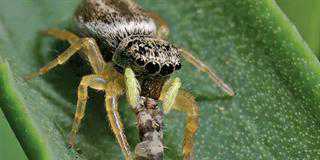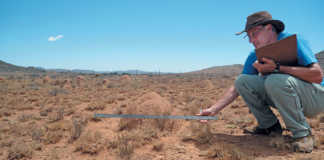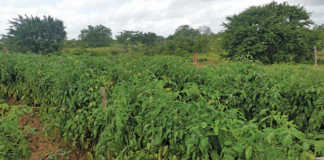Kikuyu (Pennisetum cladestinum), a sub-tropical C4 grass, forms the foundation of many pasture-based dairy operations in the major dairy producing areas of South Africa, including the Southern Cape, the region Lobke Steyn chose for her study area. Running dairy cows on kikuyu pastures is considered by many farmers to be the cheapest way of producing milk.
Kikuyu is a summer-active grass that goes dormant in winter. To manage the consequential slump in feed flow during the colder months, dairy farmers oversow the kikuyu base with rye grass in late autumn (March and April). Rye grass – annual or perennial – is a temperate, winter-active C3 grass. Farmers will generally graze the kikuyu down hard in autumn to open the canopy so that the oversown ryegrass can germinate and grow successfully.
The commonly used Italian rye grass (Lolium multiflorum), planted in March, is most productive in spring, while perennial rye (Lolium perenne) planted in April has its growth peak in early summer. Both varieties of rye grass have the same annual production – 3 200kg milk/ ha.
When rye grass growth slows down, in the coldest months between June and September, farmers compensate for shortfalls by buying in roughage (such as lucerne) or using silage, as well as increasing concentrate feeding. Steyn looked at the potential advantages of using high-fibre supplements (soya hulls and wheat bran) with limited pasture intakes, aiming to see if costs could be reduced while maintaining milk production. The non-forage fibre supplements are higher in energy than forage with less of a ruminal fill effect.
Research trial
Three groups of separately grazed cows were used in the trial:
- The low-concentrate (LC) group – fed 4kg of high-fibre concentrate/cow/day and 10kgDM pasture/cow/day;
- The medium concentrate group (MC) – fed 7kg of high-fibre concentrate/cow/day and 7kgDM pasture/cow/day;
- The high-concentrate (HC) group – fed 10kg of high fibre concentrate/cow/day and 5kgDM pasture/cow/day.
Milk yield, fat content and stocking rate of the groups are compared in the table above. Dry matter (DM) digestibility in the LC group was 82,3% with an NDF of 43,5% while DM digestibility in the HC group was lower at 73,5% with an NDF of 39,2%. The HC group used 37% less pasture than the other groups.
The milk yield of cows in the MC group was not appreciably different from that of the LC and HC groups, but the HC group had a better milk yield than the LC group. The HC group had lower milk fat than the LC and MC groups.
Ruminant nutrition is a complex process and the profitable production of milk off pastures requires the farmer to engage in a balancing act throughout the seasons. The pivot around which this balance occurs is efficient conversion, weighted by soil type, fertilisation, grass quality and production, temperature, rainfall, water availability, genes and the animal’s stage of lactation.
Energy
The primary limiting factor to the dairy cow on pasture is energy intake; the energy value (fat content) determines productivity. However, feeding concentrates to correct energy deficits elicits a positive response only up to about 4kg/cow/day, after which the response dwindles.
Increasing the concentrate portion of the ration to high-producing dairy cows can cause sub-clinical acidosis, a problem as far as production is concerned. The addition of readily fermentable carbohydrates (for example though maize inclusion) in the form of concentrates causes rumen pH to fall and fibre digestion to decrease, as it negatively affects the microbial populations.
Even a 10% to 15% addition of readily fermentable carbohydrates can impair fibre digestion, while a 30% addition can cause serious depression. Increased sub-clinical acidosis can occur at a pH of 5,8 with growing risk if the pH is held. This usually occurs after a high-concentrate portion of readily fermentable, easily digestible, carbohydrates is fed out at milking.
Fibre
The Neutral Digestible Fibre (NDF) percentage of the forage is a dry matter intake (DMI) predictor because it provides bulk or rumen fill. NDF is the measurement of fibre found in plant cell walls: lignin, cellulose and hemicellulose. The cow’s voluntary intake will be restricted when there are high levels of NDF in the diet.
As the season progresses and the grass matures, there is less leaf to stem, a decrease in nutritive value, and an increase in the NDF component of the forage. When fibre content is high, intakes are down because of ruminal fill.
Sub-tropical pasture has NDF levels of 57,5%, while temperate grasses have NDF levels of 38,4%. The C4 type grasses have lower protein levels, lower soluble sugars and are less digestible than the C3 grasses.
A dairy cow can take in 1,2% of her body weight as NDF daily. This translates into a 400kg cow with the potential of eating 4,8kg NDF/day. Effective dietary NDF forms a fibrous mat above the rumen contents, stimulating rumination as it creates a buffered environment through ruminal saliva. The buffering capacity maintains stable rumen pH.
The thickness of the fibre mat determines effective dietary NDF. High levels of rapidly fermentable concentrate in the diet reduce the effective NDF, thinning the fibrous mat, lowering saliva input and shortening rumination time. With less buffering, the pH will drop to below 6 and fibre degradation in the rumen will be compromised.
Supplement
Substituting with 25% maize in the concentrate with a non-forage fibre source such as soya hulls and wheat bran had no effect on milk protein, but increased production and fat content. The high-fibre inclusion improves fibrolyltic microbial activity but represses cellulolytic activity.
In this system, the milking cows held their production. The relationship between milk production and supplement inputs is influenced by variables such as stage of lactation and genetic potential. Reducing the percentage of maize in the supplement may have been responsible for lower-than- expected milk production.
As pasture production diminishes in winter, it seems sensible to feed more concentrate in the form of supplements. The maintenance of microbial activity and therefore rumen health by using high fibre supplements keeps milk production steady and saves on pasture. High- fibre concentrates have greater digestibility than grass forage and intakes can improve.
Increasing concentrates and reducing pasture means that the stocking rate can be increased. As pasture is the cheapest way to produce milk, avoiding pasture loss by maximising pasture intake will improve profits.
For more information, visit Stellenbosch University http://scholar.sun.ac.za and type in ‘Supplementation of high fibre concentrate to Jersey cows on pasture to overcome winter roughage shortages’.













